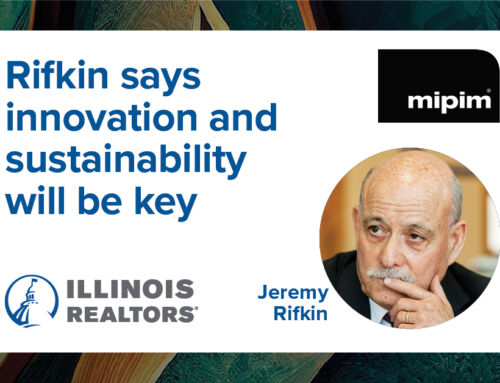Commercial sales volume is strong and the cost of those sales is trending higher even as tightened commercial real estate inventory means fewer total transactions, according to the National Association of REALTORS® (NAR) 2018 Commercial Member Profile.
What’s ahead for 2019? NAR’s Commercial Real Estate Outlook: 2018.Q3 expects the reduced corporate tax rate to spur increased consumer and investment spending, unemployment to fall even lower and the economy to shift to full capacity.
The commercial market is on track to see “solid demand and increasing cash flows,” according to the outlook. Vacancy rates will vary with multifamily experiencing growing availability, office and retail property vacancies moving sideways and steady rent growth for industrial spaces, the outlook projects.
K.C. Conway, chief economist for the CCIM Institute, and Illinois REALTOR® Marty Smith, a commercial broker in Champaign, take a closer look at what is happening in a market segment of interest to many – commercial retail.
Conway points out that even though some major retailers bowed out in 2018, the overall retail sector showed signs of strength. And Smith spotlights how old neighborhood malls can find new life as mixed-use properties.
Time to Retell the Retail Story
K.C. Conway
MAI, CRE CCIM Chief Economist & Director of Research,
Alabama Center for Real Estate at the University of Alabama
If you only read media headlines about the retail industry and recent bankruptcies and store closings, you would believe the sensational characterization that the industry is in a “retail apocalypse.” But as Col. Potter from the “MASH” television series responded to mischaracterizations, I too, would respond to the idea of a “retail apocalypse” with, “horse hockey!”
It is time to objectively re-examine the facts and retell the retail story. The real retail story in 2018 was quite the opposite of apocalyptic.
Start with retail sales and retailer earnings. Even as 2018 headlines were dominated by Toys ‘R’ Us and Mattress Firm bankruptcies, there were areas of the market that exceeded expectations. Used auto and gasoline sales were higher, as were earnings for retailers such as Home Depot, which had higher sales driven by homeowners remodeling and other rebuilding after last year’s hurricanes.
Retailers Macy’s and Kohl’s had stronger than expected earnings, boosted in part by apparel and back-to-school shoppers. And by mid-2018, Wal-Mart had posted its best earnings in a decade with even grocery and online sales up 40 percent.
If that is not enough to convince you that there isn’t a “retail apocalypse,” then how about the following performance measures?
υ By mid-2018, PREIT, a large real estate investment trust that invests in malls, said it had leased all its anchor and big-box retail vacancies. PREIT Chief Financial Officer Bob McCadden also expected no further anchor closures to be announced in 2018. PREIT also noted a 300-basis-point increase in operating results from the first quarter of 2018. When was the last time you had those kinds of results on a mall portfolio?
υ TREPP Research released a mid-year report on the state of retail and analyzed more than 34,500 retail real estate loans across the U.S. It found retail commercial mortgage-backed securities (CMBS) properties in recovering markets have posted consistent year-over-year net operating income (NOI) growth in the years following the financial crisis. Retail occupancy figures have recovered to levels just below their pre-recession prime. And retailers investing in tech innovation and experiential formats are positioning themselves to thrive in the future as the line between e-commerce and physical distribution channels converge. A few retailers at the front of that shift are PGA Superstore, Batteries Plus and Top-Golf.
Not all retail is performing to perfection, but it’s not apocalyptic either. There are two final trends to monitor in 2019, one good and the other not.
The good news is that retail buildings are increasingly being repurposed and put back into productive reuse, which enables communities to combat the blight from vacant stores and add revenue back to sales tax coffers. The CCIM Institute and the Alabama Center for Real Estate (ACRE) at the University of Alabama collaborated on a report, “Adaptive Reuse: Turning Blight into Bright,” that looks at this trend. One example worth noting is a mall converted into a warehouse outside Dallas, Texas. bit.ly/CommercialConversion
On the other side is a negative trend worth watching. At least one city outside Boston imposes a fee or tax penalizing landlords with vacant retail space and similar ideas have been under consideration in New York City and San Francisco. What’s next, a vacancy tax on empty hotel rooms or unleased apartments? Local government leaders and property tax assessors have a target on commercial real estate owners due to lost property tax revenues. They don’t understand the impact e-commerce has had on physical retail stores. Our industry needs to be vocal on this bad idea. Believe it or not, retail property owners don’t like vacant stores either.

Creating a Brighter Tomorrow for Today’s Dimming Retail Mall
Marty Smith
Commercial Broker with SVN Ramshaw Real Estate in Champaign, IL, Specializing in Client Acquisitions, Leasing, and Creative Property Portfolios
As commercial REALTORS®, we battle and overcome economic indicators, local market conditions and various buyer and seller issues with most listings. But the task of marketing and repurposing fading properties redefines that challenge, initiative and creativity.
We haven’t found the perfect “how-to” best seller, podcast, or “magic dust” to ensure success, but we can rethink the standard practice of listing a faded retail property. Papering storefronts with signage and marketing “Former Retail Space” on local, regional and national websites is no longer sufficient when it comes to backfilling dimming malls.
A fresh approach is needed to reimagine, refocus and repurpose the property.
Reshaping public perception of a property becomes an even bigger task than marketing it to potential tenants. Without constant push back and repeated messaging, the media continues to portray the evolution to a mixed-use property as a traditional retail shopping mall.
Perspectives can be changed about these mixed-use repurposing plans through social media, presentations and business networking. As public awareness grows and perceptions transform, even the smallest tenant announcements become big news creating the momentum and excitement necessary for a redirection of tenant mixed-use properties.
The Lincoln Square Mall in Urbana is an emerging example of this new approach.
It is listed on the National Register of Historic Places as the first enclosed indoor mall in the U.S. Built in 1964, it was the bustling retail center of downtown Urbana and originally included a Carson Pirie Scott multi-level department store as its anchor, surrounded by additional retail stores, family gathering space, a food court and children’s indoor play areas.
Today, with the national department store, other retail shops and bustling shoppers long gone, you will find a new variety of mixed use. It is now home to law offices, financial services, community service agencies, athletic and therapeutic services, a fitness center, faith-based organizations, a co-op grocery, eclectic local restaurants and unique specialty retail.
With more work to do and spaces to fill, the resurgence of Lincoln Square Mall is gaining momentum. Through constant remarketing, messaging and creative energy, evolving public perception of the property and community excitement are pointing to a bright future.
REALTOR® Alex Ruggieri, CCIM, CIPS, CRE, SEC,
is a senior investment advisor with SVN-Ramshaw Real Estate in Champaign.
He can be reached at [email protected].
Residential real estate in 2019: What to expect
Nationally, there has been speculation that the housing market might be softening as home sales seemed to slow in the second half of 2018 amid rising mortgage interest rates, higher home prices and the sustained issue of low inventory.
But in his 2019 forecast, NAR Chief Economist Lawrence Yun said he expects the new year to be a stable one. Yun said 2017 was one of the strongest years for home sales in a decade and 2018 is expected to end the year only marginally lower.
The NAR forecast calls for more of the same in 2019, with modest gains in home sales and a slowdown of home price appreciation, which will surely be good news for prospective homebuyers who have an eye toward affordability. Find the full NAR forecast at bit.ly/NAR_Outlook2019.
Wondering about the housing forecast for Illinois? The Regional Economics Applications Laboratory (REAL) at the University of Illinois is forecasting positive gains in home sales and continued growth in median prices, although within a narrower range than 2018. Find highlights of next year’s forecast in Market Watch on page 30 and the entire forecast at www.IllinoisRealtors.org/MarketStats.





















